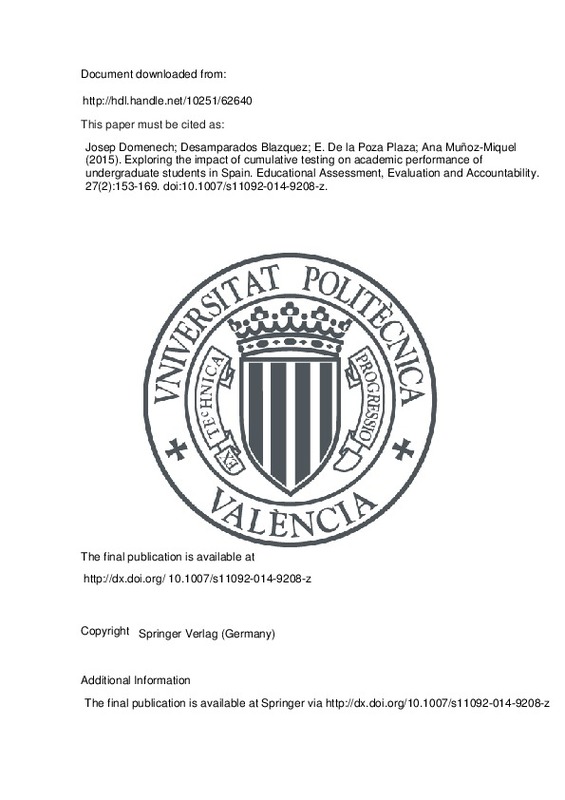Adelman, HS, & Taylor, L. (1990). Intrinsic motivation and school misbehaviour some intervention implications. Journal of Learning Disabilities, 23, 541–550.
Biggs, J, & Tang, C. (2007). Teaching for quality learning at university 3rd edn. Open University Press.
Boston, C. (2002). The concept of formative assessment. Practical Assessment Research & Evaluation 8.
[+]
Adelman, HS, & Taylor, L. (1990). Intrinsic motivation and school misbehaviour some intervention implications. Journal of Learning Disabilities, 23, 541–550.
Biggs, J, & Tang, C. (2007). Teaching for quality learning at university 3rd edn. Open University Press.
Boston, C. (2002). The concept of formative assessment. Practical Assessment Research & Evaluation 8.
Brown, GA, Bull, J, Pendlebury, M. (1997). Assessing Student Learning in Higher Education, 1st edn. Routledge.
Cano, MD. (2011). Students’ involvement in continuous assessment methodologies: a case study for a distributed information systems course. IEEE Transactions on Education, 54, 442–451.
Casem, ML (2006). Active learning is not enough. Journal of College Science Teaching, 35.
Chen, J, & Lin, TF. (2008). Class attendance and exam performance a randomized experiment. The Journal of Economic Education, 39, 213–227.
Chickering, AW, & Gamson, ZF. (1987). Seven principles for good practice in undergraduate education. American Association for Higher Education Bulletin, 39, 3–7.
Crooks, TJ. (1988). The impact of classroom evaluation practices on students. Review of Educational Research, 58, 438–481.
De Paola, M, & Scoppa, V. (2011). Frequency of examinations and student achievement in a randomized experiment. Economics of Education Review, 30, 1416–1429.
Deck, W. (1998). The effects of frequency of testing on college students in a principles of marketing course, PhD thesis, Virginia Polytechnic Institute and State University. Virginia: Blacksburg.
Dempster, FN. (1991). Synthesis of research on reviews and tests. Educational Leadership, 48, 71–76.
Dochy, F. (2008). The Edumetric Quality of New Modes of Assessment: Some Issues and Prospects. Assessment, Learning and Judgement in Higher Education. Dordrecht: Springer Netherlands.
Eikner, AE, & Montondon, L. (2001). Evidence on factors associated with success in intermediate accounting I. Accounting Educators’ Journal 13.
Emerson, TLN, & Mencken, KD. (2011). Homework to require or not? online graded homework and student achievement Perspectives on Economic Education Research 7.
Fulkerson, F, & Martin, G. (1981). Effects of exam frequency on student performance, evaluations of instructor, and test anxiety. Teaching of Psychology, 8, 90–93.
Furnham, A, & Chamorro-Premuzic, T. (2005). Individual differences and beliefs concerning preference for university assessment methods. Journal of Applied Social Psychology, 35, 1968–1994.
Gibbs, G, & Simpson, C. (2005). Conditions under which assessment supports students’ learning Learning and Teaching in Higher Education 1 (August 5, 2011)3–31.
Haberyan, KA. (2003). Do weekly quizzes improve student performance on general biology exams?. The American Biology Teacher, 65, 110–114.
Kling, N, McCorkle, D, Miller, C, Reardon, J. (2005). The impact of testing frequency on student performance in a marketing course. Journal of Education for Business, 81, 67–72.
Kuh, GD (2003). What we’re learning about student engagement from NSSE Change 35.
Kuo, T, & Simon, A. (2009). How many tests do we really need. College Teaching, 57, 156–160.
Leeming, FC. (2002). The exam-a-day procedure improves performance in psychology classes. Teaching of Psychology, 29, 210–212.
Lumsden, KG, Scott, A, Becker, WE. (1987). The economics student reexamined Male-female differences in comprehension. Journal of Economic Education, 18, 365–375.
Marriott, P. (2009). Students’ evaluation of the use of online summative assessment on an undergraduate financial accounting module. British Journal of Educational Technology, 40, 237–254.
Marriott, P, & Lau, A. (2008). The use of on-line summative assessment in an undergraduate financial accounting course. Journal of Accounting Education, 26, 73–90.
McNabb, R, Pal, S, Sloane, P. (2002). Gender differences in educational attainment. the case of university students in england and wales. Economica, 69, 481–503.
Miller, F. (1987). Test frequency, student performance and teacher evaluation in the basic marketing class. Journal of Marketing Education, 9, 14–19.
Nicol, DJ, & Macfarlane Dick, D. (2006). Formative assessment and self-regulated learning, A model and seven principles of good feedback practice. Studies in Higher Education, 31, 199–218.
Nowell, C, & Alston, RM. (2007). I thought I got an A! Overconfidence across the economics curriculum. The Journal of Economic Education, 38, 131–142.
Race, P (1995). The art of assessing 1 New Academic 4.
Scriven, M. (1967). The Methodology of Evaluation, vol 1 (pp. 39–83). Chicago: Rand McNally.
Skinner, BF. (1974). About behaviorism. New York: Alfred A Knopf.
Taras, M. (2005). Assessment - summative and formative - some theoretical reflections. British Journal of Educational Studies, 53, 466–478.
Trotter, E. (2006). Student perceptions of continuous summative assessment. Assessment & Evaluation in Higher Education, 31, 505–521.
Yorke, M. (2003). Formative assessment in higher education: Moves towards theory and the enhancement of pedagogic practice. Higher Education, 45, 477–501.
[-]







![[Cerrado]](/themes/UPV/images/candado.png)


